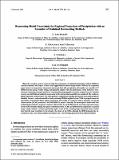Por favor, use este identificador para citar o enlazar a este item:
http://hdl.handle.net/10261/170628COMPARTIR / EXPORTAR:
 SHARE SHARE
 CORE
BASE CORE
BASE
|
|
| Visualizar otros formatos: MARC | Dublin Core | RDF | ORE | MODS | METS | DIDL | DATACITE | |

| Título: | Reassessing model uncertainty for regional projections of precipitation with an ensemble of statistical downscaling methods |
Autor: | San-Martín, Daniel; Manzanas, Rodrigo CSIC ORCID; Brands, Swen CSIC ORCID CVN; Herrera, Sixto CSIC ORCID CVN; Gutiérrez, José M. CSIC ORCID | Palabras clave: | Climate change Statistical forecasting Ensembles Climate prediction Statistical techniques |
Fecha de publicación: | 2017 | Editor: | American Meteorological Society | Citación: | Journal of Climate 30(1): 203-223 (2017) | Resumen: | This is the second in a pair of papers in which the performance of statistical downscaling methods (SDMs) is critically reassessed with respect to their robust applicability in climate change studies. Whereas the companion paper focused on temperatures, the present manuscript deals with precipitation and considers an ensemble of 12 SDMs from the analog, weather typing, and regression families. First, the performance of the methods is cross-validated considering reanalysis predictors, screening different geographical domains and predictor sets. Standard accuracy and distributional similarity scores and a test for extrapolation capability are considered. The results are highly dependent on the predictor sets, with optimum configurations including information from midtropospheric humidity. Second, a reduced ensemble of well-performing SDMs is applied to four GCMs to properly assess the uncertainty of downscaled future climate projections. The results are compared with an ensemble of regional climate models (RCMs) produced in the ENSEMBLES project. Generally, the mean signal is similar with both methodologies (with the exception of summer, which is drier for the RCMs) but the uncertainty (spread) is larger for the SDM ensemble. Finally, the spread contribution of the GCM- and SDM-derived components is assessed using a simple analysis of variance previously applied to the RCMs, obtaining larger interaction terms. Results show that the main contributor to the spread is the choice of the GCM, although the SDM dominates the uncertainty in some cases during autumn and summer due to the diverging projections from different families. | Versión del editor: | https://doi.org/10.1175/JCLI-D-16-0366.1 | URI: | http://hdl.handle.net/10261/170628 | DOI: | 10.1175/JCLI-D-16-0366.1 | Identificadores: | doi: 10.1175/JCLI-D-16-0366.1 issn: 0894-8755 e-issn: 1520-0442 |
| Aparece en las colecciones: | (IFCA) Artículos |
Ficheros en este ítem:
| Fichero | Descripción | Tamaño | Formato | |
|---|---|---|---|---|
| reassmetho.pdf | 5,86 MB | Adobe PDF |  Visualizar/Abrir |
CORE Recommender
SCOPUSTM
Citations
53
checked on 25-abr-2024
WEB OF SCIENCETM
Citations
53
checked on 23-feb-2024
Page view(s)
272
checked on 30-abr-2024
Download(s)
256
checked on 30-abr-2024
Google ScholarTM
Check
Altmetric
Altmetric
NOTA: Los ítems de Digital.CSIC están protegidos por copyright, con todos los derechos reservados, a menos que se indique lo contrario.


